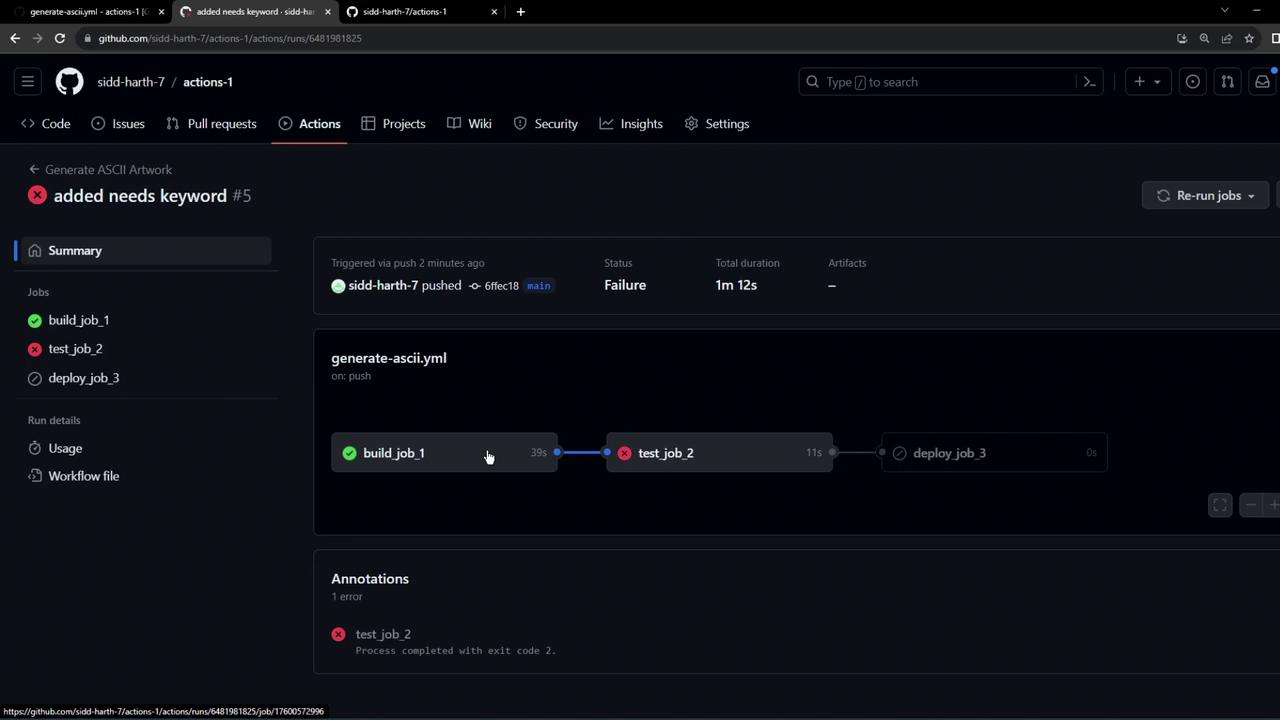GitHub Actions
GitHub Actions Core Concepts
Execute multiple jobs in Sequence using needs
Use the needs syntax in GitHub Actions to control job execution order. In this tutorial, you'll chain build_job_1, test_job_2, and deploy_job_3 so that each runs only after its dependency succeeds.
How needs Works
Note
The needs keyword, defined at the job level, accepts a single job name or an array of job names. A job won't start until all its specified dependencies complete successfully.
1. Basic Build + Test Workflow
Here’s a minimal workflow where test_job_2 waits for build_job_1:
name: Generate ASCII Artwork
on:
push:
jobs:
build_job_1:
runs-on: ubuntu-latest
steps:
- name: Install Cowsay
run: sudo apt-get install cowsay -y
- name: Generate message
run: cowsay -f dragon "Run for cover, I am a DRAGON....RAWR" >> dragon.txt
- name: Pause for 30 seconds
run: sleep 30
test_job_2:
needs: build_job_1
runs-on: ubuntu-latest
steps:
- name: Pause for 10 seconds
run: sleep 10
- name: Verify file exists
run: test -f dragon.txt
With this setup, test_job_2 only starts once build_job_1 finishes without errors.
2. Detecting Cyclic Dependencies
If you introduce a cycle, GitHub Actions will reject your workflow before it runs.
Warning
Circular dependencies (e.g., build_job_1 needs test_job_2 and vice versa) are invalid. The runner throws an error on push.
Invalid example:
jobs:
build_job_1:
needs: test_job_2 # ❌ Invalid: cycle detected
runs-on: ubuntu-latest
steps:
- run: echo "Building..."
test_job_2:
needs: build_job_1
runs-on: ubuntu-latest
steps:
- run: echo "Testing..."
3. Adding a Deploy Phase
You can chain multiple jobs by listing dependencies as an array. Below is a full build–test–deploy sequence:
name: Generate ASCII Artwork
on:
push:
jobs:
build_job_1:
runs-on: ubuntu-latest
steps:
- name: Install Cowsay
run: sudo apt-get install cowsay -y
- name: Generate message
run: cowsay -f dragon "Run for cover, I am a DRAGON....RAWR" >> dragon.txt
- name: Pause for 30 seconds
run: sleep 30
test_job_2:
needs: build_job_1
runs-on: ubuntu-latest
steps:
- name: Pause for 10 seconds
run: sleep 10
- name: Verify content
run: grep -i "dragon" dragon.txt
deploy_job_3:
needs: [test_job_2]
runs-on: ubuntu-latest
steps:
- name: Display file
run: cat dragon.txt
Job Dependency Table
| Job | needs | Purpose |
|---|---|---|
| build_job_1 | — | Installs Cowsay and generates dragon.txt |
| test_job_2 | build_job_1 | Verifies that dragon.txt contains "dragon" |
| deploy_job_3 | [test_job_2] | Outputs the contents of dragon.txt |
4. Observing the Workflow Run
When you push this workflow:
- The GitHub Actions graph displays:
build_job_1 → test_job_2 → deploy_job_3 - Each job runs on a separate runner; files are not shared by default.
- If
test_job_2fails to finddragon.txt, the runner skipsdeploy_job_3:
grep -i "dragon" dragon.txt
# exit status 1

Note
To share files between jobs, explicitly upload and download artifacts using the actions/upload-artifact and actions/download-artifact actions.
References
Watch Video
Watch video content